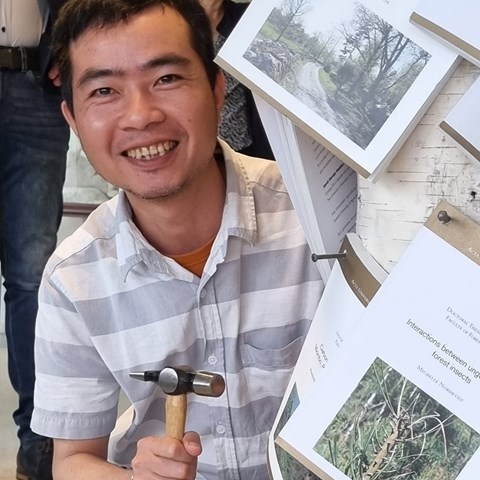Contact
Department of Crop Production Ecology, Agricultural cropping systems

On Friday, Hung Van Do will defend his doctoral thesis. He has demonstrated that it is possible to increase yields and profitability in highland farming areas in northwest Vietnam if farmers adopt a practice known as agroforestry, which involves cultivating trees alongside perennial and/or annual crops.
Hung Van Do comes from Vietnam but has pursued his doctorate at SLU. Three weeks ago, he nailed his thesis on the "thesis tree" in the lunchroom at the Ecology Centre in Ultuna (a symbolic tradition before defending one's thesis). The title is "Fruit tree-based agroforestry on sloping uplands in northwest Vietnam."
"Much of the research was conducted in the fields in Vietnam. I was able to analyze the collected data in Sweden during the winter months, but I could only be in Sweden during the years just before and after the Covid 19 pandemic," he explains.
This Friday, it's time for his dissertation. Hung Van Do is looking forward to it and finds it exciting to discuss his findings. We asked him three questions.
What have you discovered?
"My research demonstrates that fruit tree-based farming systems, such as those involving mango or plum trees alongside corn, coffee, and forage grasses, not only result in a more diversified production but also yield higher overall, compared to sole crop cultivation of annual crops on sloping uplands. From the second year of cultivation, the trial produced higher total yields of forage grass and other crops per unit of land. When the trees began bearing fruit in the third and fourth years, the volume of products increased even further. In addition, grass strips and fruit trees planted along the contour lines play a significant role in reducing soil and nutrient losses on sloping land by forming natural terraces.”
What are the challenges associated with intercropping fruit trees and other crops?
"Farmers may need financial support to initiate this type of farming system, as it requires some initial investments and it take some years for trees to bear fruit. An uncertain and unstable market for certain agricultural products poses a barrier. Even though the total yield per unit area increased, individual crops generally grew slower and had lower yields when intercropped as compared to pure stands, likely due to competition for light, water and nutrients. The system also requires more labor-intensive activities, such as weed control."
Do you recommend farmers to adopt agroforestry?
"My research focuses on small farms located in sloping uplands in northwest Vietnam. We will continue to study production, soil conservation, tree and crop development, and the effects of various weed control methods. There is still more research to be done in this area, but given that this farming system provides more diverse and higher total yields while being beneficial for long-term sustainability in agriculture, I believe we can optimize the system so that more farmers will be willing to adopt it. Agroforestry with fruit trees helps reduce soil erosion on steep slopes. The terraces formed reduce the losses of organic carbon and plant nutrients by 20 to 84 percent compared to sole crop cultivation."